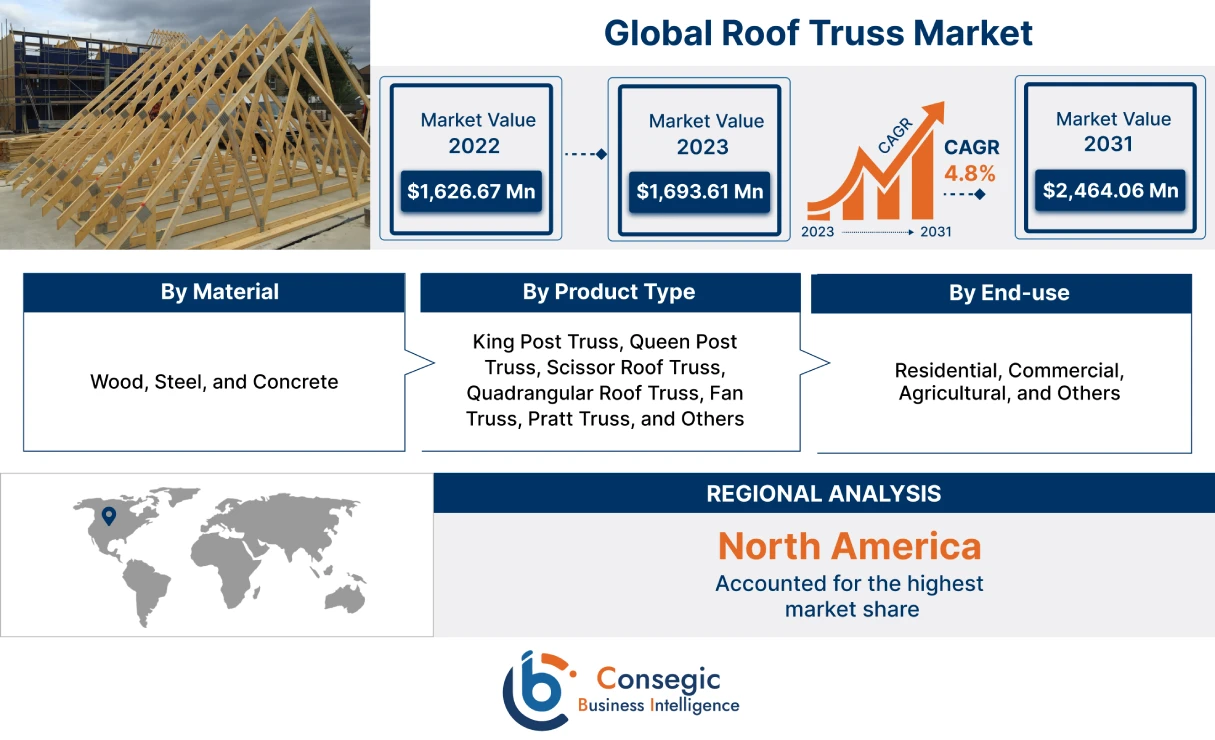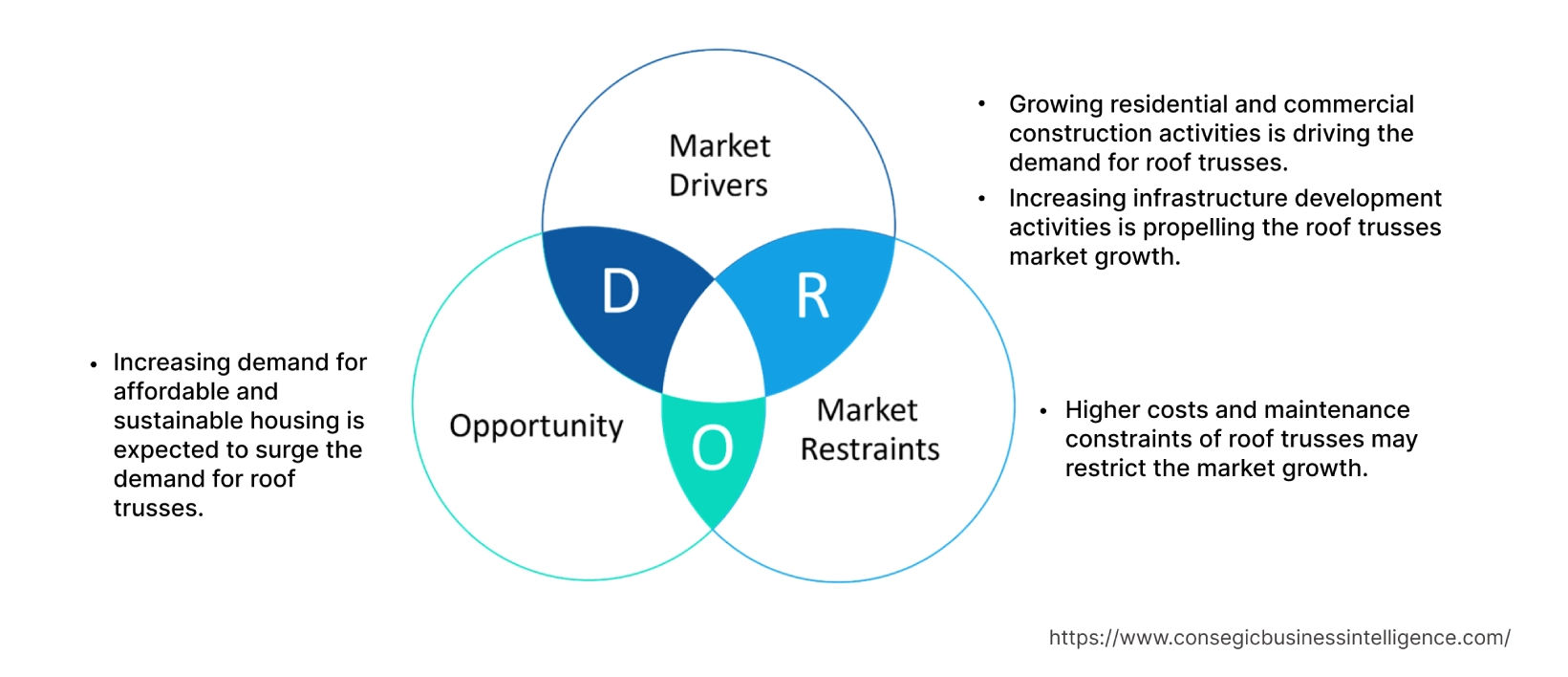Roof Truss Market Introduction :
Consegic Business Intelligence analyzes that the roof truss market is growing with a CAGR of 4.8% during the forecast period (2023-2031), and the market is projected to be valued at USD 2,464.06 Million by 2031 and USD 1,693.61 Million by 2023 from USD 1,626.67 Million in 2022.
Roof Truss Market Definition & Overview:
A roof truss is a prefabricated structural framework of interconnected members that is used to support a building's roof. Roof trusses are typically triangular in shape, but can also be designed in other shapes to suit the specific needs of a project. Roof trusses are typically made of wood or metal, but they can also be made of other materials such as concrete or composite materials. The product provides strength, stability, and durability to a building or a structure, facilitating resistance from the forces of nature and load. The major components of a roof truss include the top chord, bottom chord, ties, struts, purlins, rafters, ridge line, eaves, panel points, roof covering, base plate, anchor plate, and anchor bolts.
Roof Truss Market Insights :
Key Drivers :
Growing residential and commercial construction activities is driving the demand for roof trusses
Roof trusses are being widely used in the construction of residential and commercial buildings owing to the numerous structural benefits associated with the product. Roof truss offers a flexible solution in the construction of roofs that need to be strong as well as spacious and can be used in any type of building, irrespective of size or purpose. Their flexibility in layout design allows for versatile use, and they are particularly useful in modern buildings that prioritize openness and adaptability. Owing to the mentioned factors, roof trusses are being widely used in various residential & commercial building projects, which in turn is driving the market growth of the product. For instance, according to a report by Oxford Economics, the global construction output in 2020 was valued at around USD 10.7 trillion and is expected to reach USD 15.2 trillion by 2030. The growth in construction activities across the globe is enhancing the utilization of roof truss which in turn is driving the market growth of the product.
Increasing infrastructure development activities is propelling the roof trusses market growth
Roof trusses are used across a wide range of infrastructural and industrial projects such as bridges, towers, industrial buildings, airport terminals, warehouses, aircraft hangers, stadiums, factories, workshops, and others. The strong load bearing capacity of roof trusses is a key factor attributed to the wide application of the product in civil engineering works. Moreover, roof trusses offer a highly efficient solution for spanning long distances with minimal material usage. Since the truss members are subjected to axial loads through compression or tension, it makes the system more efficient requiring less material as the force is distributed uniformly among the members. Thus, the utilization of less material makes the construction cost-effective owing to which roof trusses are being widely used in various industrial & infrastructural projects across the globe. For instance, in November 2021, the U.S. government approved a USD 2 trillion infrastructure plan which included the upgradation of physical infrastructure such as roads and bridges, railways, airports, and water systems. The rise in infrastructure development projects is enhancing the application of roof trusses across the sector, driving the market growth of the product.
Key Restraints :
Higher costs and maintenance constraints of roof trusses may restrict the market growth
Roof trusses are prefabricated and require specialized equipment to install. Hence, it is more expensive than other roofing materials, such as shingles or metal roofing. In addition to this, the maintenance of roof trusses is comparatively costly and time-consuming. Hence, the aforementioned factors are likely to hamper the growth of the roof truss market, especially in developing countries.
Future Opportunities :
Increasing demand for affordable and sustainable housing is expected to surge the demand for roof trusses
Roof trusses are made from prefabricated wooden or metal trusses that are assembled on-site. This makes it faster and easier to install than other traditional roof framing methods. As a result, roof trusses are a sustainable way to build roofs and have gained popularity in the construction of affordable housing. Moreover, roof trusses are very strong and durable, which can help to extend the lifespan of a roof and reduce the need for repairs. Additionally, these roofs can help to improve the energy efficiency of a building by providing better insulation and ventilation. Therefore, as the demand for affordable and sustainable housing continues to grow, the demand for roof trusses is also expected to increase over the forecast period.
Roof Truss Market Report Insights :
| Report Attributes | Report Details |
| Study Timeline | 2017-2031 |
| Market Size in 2031 | USD 2,464.06 Million |
| CAGR (2023-2031) | 4.8% |
| By Material | Wood, Steel, and Concrete |
| By Product Type | King Post Truss, Queen Post Truss, Scissor Roof Truss, Quadrangular Roof Truss, Fan Truss, Pratt Truss, and Others |
| By End-use | Residential, Commercial, Agricultural, and Others |
| By Region | North America, Europe, Asia-Pacific, Latin America, and Middle East & Africa |
| Key Players | ENDO TRUSS, Minera Roof Trusses, AAA Trusses and Windows, Donaldson Timber Engineering Ltd, Scotts of Timber, Stark Truss, Truss-Tech Limited, Nuneaton Roof Truss Limited, Wilson Roof Truss Ltd, Thomas Armstrong (Timber) Ltd, and Magtruss Ltd |
Roof Truss Market Segmental Analysis :
Based on the Product Type :
The product type segment is classified into king post truss, queen post truss, scissor roof truss, quadrangular roof truss, fan truss, pratt truss, and others. In 2022, the king post truss segment accounted for the highest market share of the roof truss market. The king post truss is majorly used in small to medium-sized buildings such as houses, garages, and barns. The major components of a king post truss include a vertical central post, two diagonal rafters, and a horizontal tie beam. The king post truss is easy to construct and offers a cost-effective solution for roofs with spans up to 16 meters. It is also aesthetically pleasing and adds a traditional look to the building's architecture. Owing to the mentioned factors, the king post truss is widely used in various residential & commercial construction which in turn is driving the market growth of the product.
However, the scissor roof truss segment is anticipated to grow at the fastest CAGR over the projected timeframe. A scissor roof truss is majorly used in building construction to support a pitched roof with a sloped or raised ceiling surface. Moreover, factors such as low cost and ease of installation are expected to enhance the utilization of scissor roof truss in building construction which should drive the market growth of the product over the forecast period.
Based on the Material :
The material segment is categorized into wood, steel, and concrete roof trusses. In 2022, the wood segment accounted for the highest market share of 60.49% in the overall roof truss market. The wide application of wood roof truss in residential and commercial construction projects across the globe is a major factor driving the market growth of the product. Wood roof trusses offer a higher strength to weight ratio and a greater flexibility in floor plan layout. Moreover, other factors include cost effectiveness, energy efficiency, eco-friendliness, resistance to electrical & heat conduction, sound absorbent, and aesthetically pleasing. Owing to the mentioned factors, wood roof trusses are being widely used in the construction of residential and commercial buildings which in turn is driving the market growth of the product.
However, the steel segment is expected to grow at the fastest CAGR over the forecast period. The increasing usage of steel roof truss across infrastructure and industrial projects across the globe such as bridges, factories, and warehouses is expected to drive the market growth of the product over the projected timeframe.
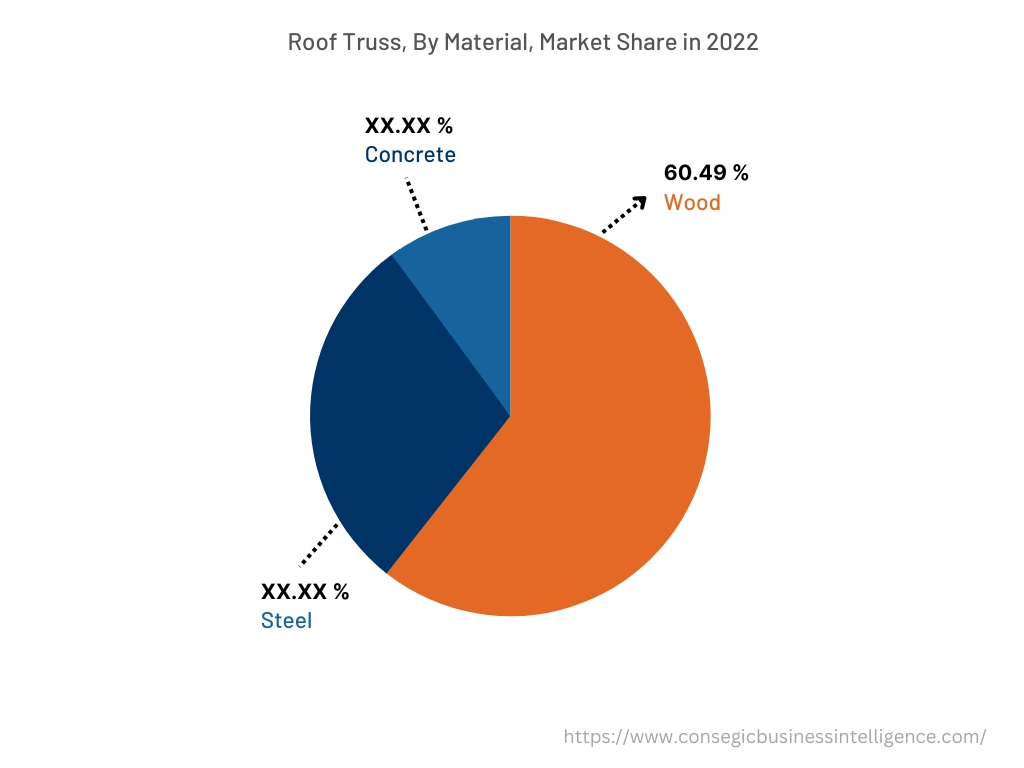
Based on the End-User :
The end-use segment is divided into residential, commercial, agricultural, and others. In 2022, the residential segment accounted for the highest market share of the roof truss market. Roof trusses are widely used in residential construction owing to their versatility, strength, and cost-effectiveness. Roof trusses can be used in a variety of roof shapes, including gable, hip, flat, and gambrel roofs. The growing application of roof trusses in residential constructions is a major factor driving the market growth of the product across the sector. For instance, according to data by the U.S. Census Bureau, in 2022 the new home construction output in the U.S. private sector reached around USD 900 billion.
The agricultural segment is anticipated to grow at the fastest CAGR over the forecast period. Roof trusses are used in agricultural buildings such as barns & stables, machine sheds, riding arenas, and recreation areas owing to their space efficiency and affordability.
Based on the Region :
The regional segment includes North America, Europe, Asia Pacific, Middle East and Africa, and Latin America.
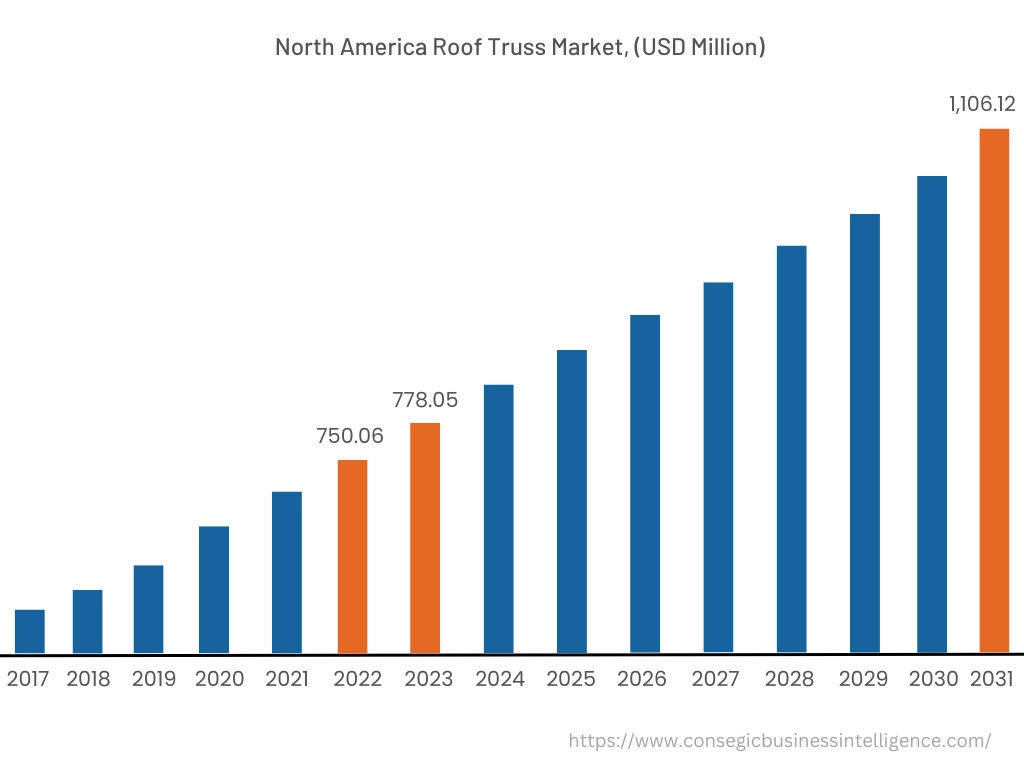
In 2022, North America accounted for the highest market share of the roof truss market at 46.11% valued at USD 750.06 million in 2022, and USD 778.05 million in 2023 and is expected to reach USD 1,106.12 million in 2031. In North America, the U.S. accounted for the highest market share of 68.23% in the region. Prefabricated construction is becoming increasingly popular in North America, as it offers several advantages over traditional construction methods, such as reduced construction time and costs, and improved quality control. Roof trusses are a key component of prefabricated construction, in turn contributing to the growing demand for roof truss in the region.
However, Europe is expected to grow at the fastest CAGR of 5.5% in the roof truss market. The key factor fostering the market growth in the region is attributed to the increasing demand for renovation or refurbishment of buildings. In addition to this, the European government is emphasizing the adoption of energy-efficient buildings. Roof trusses offer several energy-efficiency benefits, such as improved insulation and ventilation. Hence, the rising government incentives are likely to make roof truss replacement more affordable, which is expected to boost demand over the forecast period.
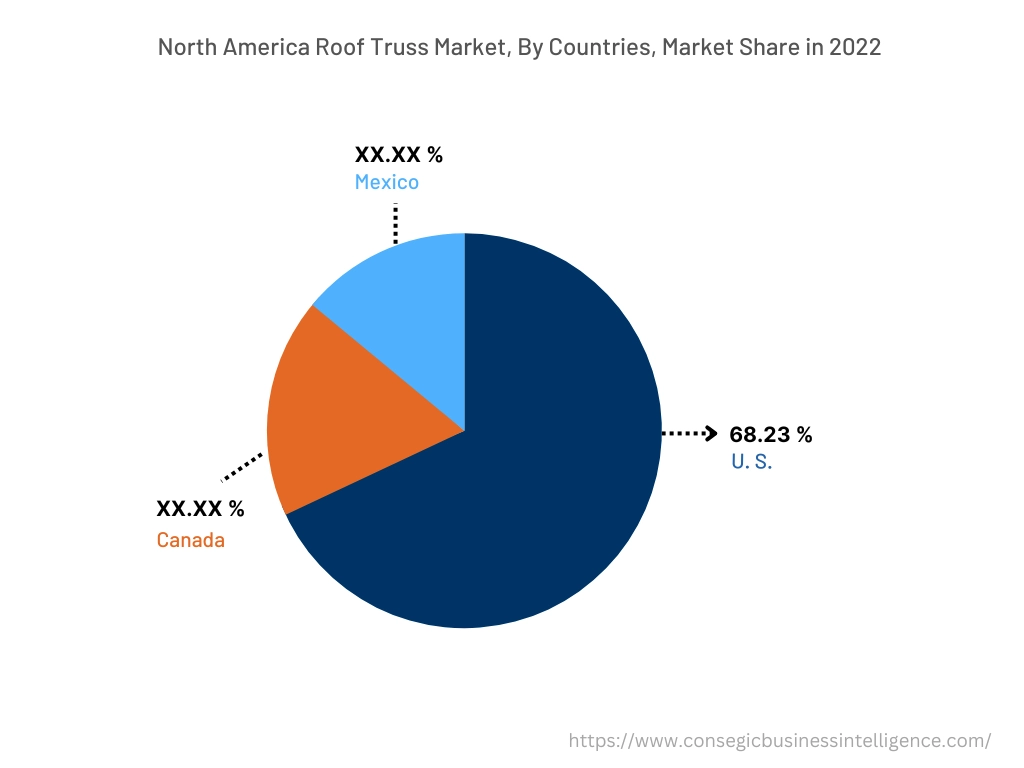
Top Key Players & Market Share Insights:
The roof truss market is highly competitive, with several large players and numerous small and medium-sized enterprises. These companies have strong research and development capabilities and a strong presence in the market through their extensive product portfolios and distribution networks. The market is characterized by intense competition, with companies focusing on expanding their product offerings and increasing their market share through mergers, acquisitions, and partnerships. The key players in the market include-
- Minera Roof Trusses
- Donaldson Timber Engineering Ltd
- Nuneaton Roof Truss Limited
- Wilson Roof Truss Ltd
- Thomas Armstrong (Timber) Ltd
- Magtruss Ltd
- Scotts of Timber
- Endo Truss
- AAA Trusses and Windows
- Stark Truss
- Truss-Tech Limited
Recent Industry Developments :
- In June 2023, Donaldson Timber Engineering opened a new branch in the UK in the southwest of England. The new site would manufacture and supply roof trusses for the UK housebuilding industry.
- In September 2020, Stark Truss expanded its capacity by constructing a 12,000-square-foot building to provide lumber and product storage. The strategic initiative led to the creation of around 20 jobs.
Key Questions Answered in the Report
What was the market size of the roof truss industry in 2022? +
In 2022, the market size of roof truss was USD 1,626.67 million.
What will be the potential market valuation for the roof truss industry by 2031? +
In 2031, the market size of roof truss will be expected to reach USD 2,464.06 million.
What are the key factors driving the growth of the roof truss market? +
Significant growth in infrastructure development and urbanization projects across the globe is fueling market growth at the global level.
What is the dominating segment in the roof truss market by the end user? +
In 2022, the infrastructure segment accounted for the highest market share in the overall roof truss market.
Based on current market trends and future predictions, which geographical region is the dominating region in the roof truss market? +
North America accounted for the highest market share in the overall roof truss market.
